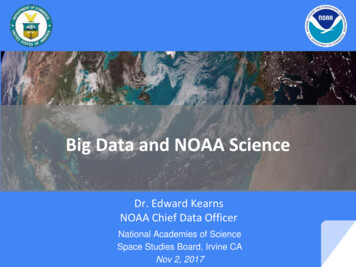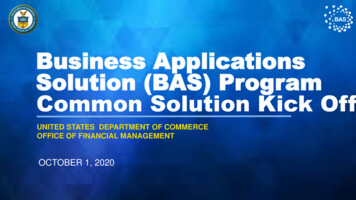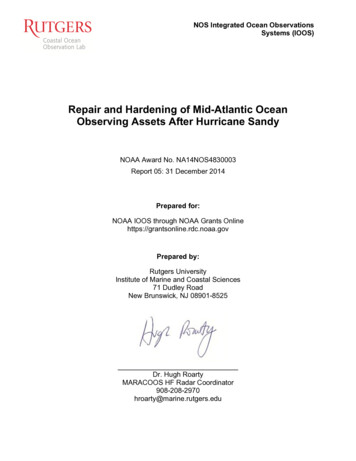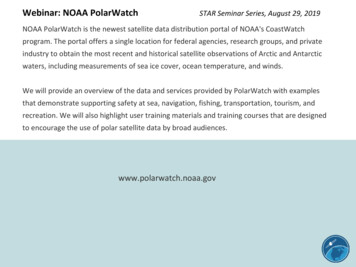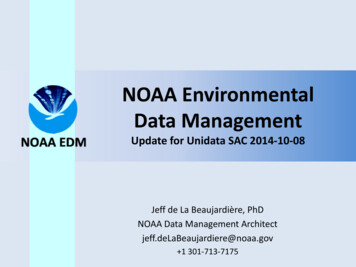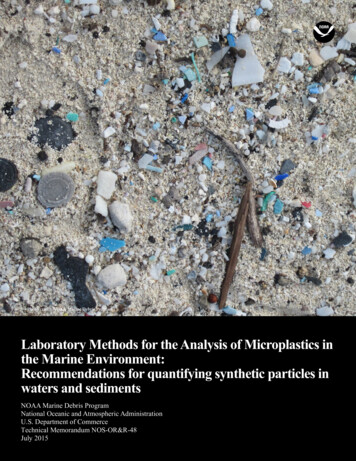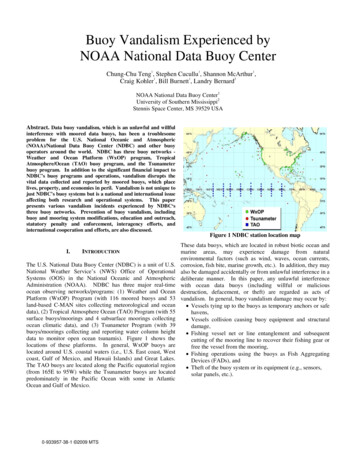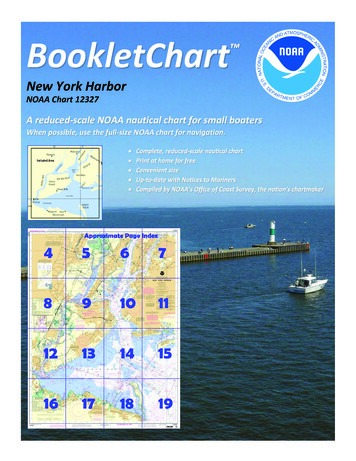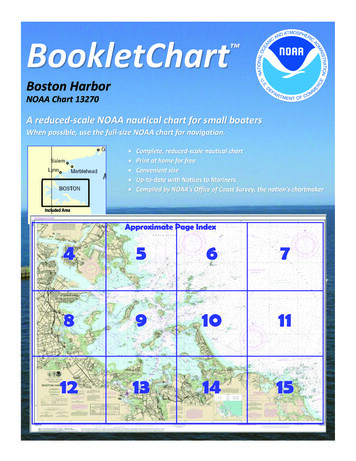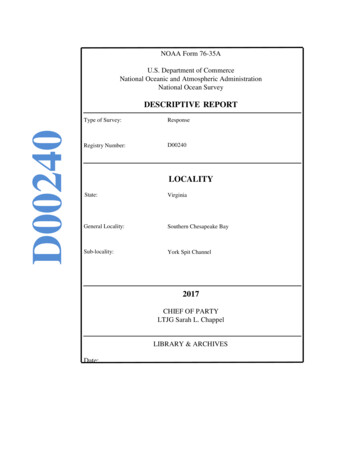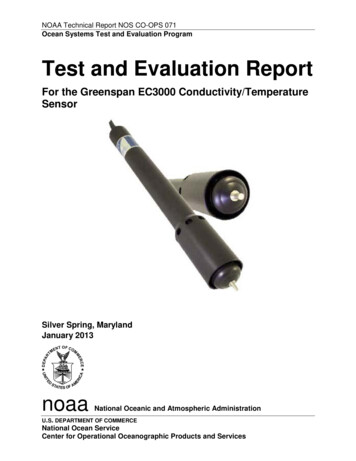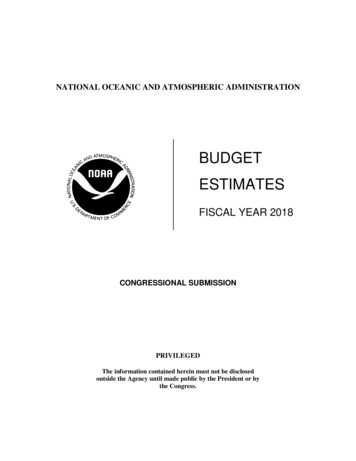
Transcription
NATIONAL OCEANIC AND ATMOSPHERIC ADMINISTRATIONBUDGETESTIMATESFISCAL YEAR 2018CONGRESSIONAL SUBMISSIONPRIVILEGEDThe information contained herein must not be disclosedoutside the Agency until made public by the President or bythe Congress.
Budget Estimates, Fiscal Year 2018Congressional SubmissionTable of ContentsExhibit No.Page No.Summary Materials1234a103233Table of ContentsOrganization ChartExecutive SummaryIncreases/Decreases/TerminationsProgram and Performance: Direct ObligationsJustification of Proposed Language ChangesAppropriations Requiring Authorizing LegislationResearch and DevelopmentHeadquarters Administrative CostsNOAA Control TableiviiixExhibit 4aExhibit 10 – 1Exhibit 32-1Exhibit 33 – 1R&D - 1HQ Admin - 1Control Table – 1Appropriation: Operations, Research, and Facilities567916343536Summary of Resource RequirementsProgram and Performance: Reimbursable ObligationsSummary of FinancingJustification of Adjustments to BaseSummary of Resource Requirements by Object ClassConsulting and Related ServicesPeriodicals, Pamphlets, and Audiovisual ServicesAverage Grade and SalariesORF – 1ORF – 5ORF – 9ORF – 11ORF – 19ORF – 23ORF – 25ORF – 27Appropriation: Procurement, Acquisition, and Construction57916Summary of Resource RequirementsSummary of FinancingJustification of Changes to BaseSummary of Requirements by Object ClassPAC – 1PAC – 5PAC – 7PAC – 9National Ocean ServiceNOS OverviewNOS – 1NOS Operations, Research, and Facilities12-15Navigation, Observations and PositioningJustification of Program and ChangesNOS – 312-15Coastal Science and AssessmentJustification of Program and ChangesNOS – 15i
12-15Ocean and Coastal Management and ServicesJustification of Program and ChangesNOS – 24NOS Procurement, Acquisition, and Construction12-15NOS ConstructionJustification of Program and ChangesNOS – 3812516Damage Assessment and Restoration Revolving FundSummary of Resource Requirements: Direct ObligationsSummary of Requirements by Object ClassNOS – 43NOS – 45NOS – 4712516Sanctuaries Enforcement Asset Forfeiture FundSummary of Resource Requirements: Direct ObligationsSummary of Requirements by Object ClassNOS – 49NOS – 51NOS – 5312516Gulf Coast Ecosystem Restoration Science, Observation,Monitoring and Technology FundSummary of Resource Requirements: Direct ObligationsSummary of Requirements by Object ClassNOS – 55NOS – 57NOS – 59National Marine Fisheries ServiceNMFS OverviewNMFS – 1NMFS Operations, Research, and Facilities12-15Protected Resources Science and ManagementJustification of Program and ChangesNMFS – 412-15Fisheries Science and ManagementJustification of Program and ChangesNMFS – 1312EnforcementJustification of ProgramNMFS – 4012-15Habitat Conservation and RestorationJustification of Program and ChangesNMFS – 4512-15516Pacific Coastal Salmon Recovery FundJustification of Program and ChangesSummary of Resource Requirements: Direct ObligationsSummary of Requirements by Object ClassNMFS – 52NMFS – 59NMFS – 6112516Fishermen's Contingency FundSummary of Resource Requirements: Direct ObligationsSummary of Requirements by Object ClassNMFS – 63NMFS – 65NMFS – 67ii
12516Foreign Fishing Observer FundSummary of Resource Requirements: Direct ObligationsSummary of Requirements by Object ClassNMFS – 69NMFS – 71NMFS – 7312516Fisheries Finance Program AccountSummary of Resource Requirements: Direct ObligationsSummary of Requirements by Object ClassNMFS – 75NMFS – 77NMFS – 7912516Promote and Develop Fisheries ProductsSummary of Resource Requirements: Direct ObligationsSummary of Requirements by Object ClassNMFS – 81NMFS – 83NMFS – 8512516Federal Ship Financing FundSummary of Resource Requirements: Direct ObligationsSummary of Requirements by Object ClassNMFS – 87NMFS – 89NMFS – 9112516Environmental Improvement and Restoration FundSummary of Resource Requirements: Direct ObligationsSummary of Requirements by Object ClassNMFS – 93NMFS – 95NMFS – 9712516Limited Access System Administration FundSummary of Resource Requirements: Direct ObligationsSummary of Requirements by Object ClassNMFS – 99NMFS – 101NMFS – 10312516Marine Mammal Unusual Mortality Event FundSummary of Resource Requirements: Direct ObligationsSummary of Requirements by Object ClassNMFS – 105NMFS – 107NMFS – 10912516Western Pacific Sustainable Fisheries FundSummary of Resource Requirements: Direct ObligationsSummary of Requirements by Object ClassNMFS – 111NMFS – 113NMFS – 11512516Fisheries Asset Forfeiture FundSummary of Resource Requirements: Direct ObligationsSummary of Requirements by Object ClassNMFS – 117NMFS – 119NMFS – 12112516North Pacific Observer FundSummary of Resource Requirements: Direct ObligationsSummary of Requirements by Object ClassNMFS – 123NMFS – 125NMFS – 127Oceanic and Atmospheric ResearchOAR OverviewOAR – 1OAR Operations, Research, and Facilities12-15Climate ResearchJustification of Program and ChangesiiiOAR – 8
12-15Weather and Air Chemistry ResearchJustification of Program and ChangesOAR – 2212-15Ocean, Coastal, and Great Lakes ResearchJustification of Program and ChangesOAR – 4312-15Innovative Research and TechnologyJustification of Program and ChangesOAR – 62OAR Procurement, Acquisition, and Construction12-15OAR Systems AcquisitionJustification of Program and ChangesOAR – 64National Weather Service12-15NWS OverviewNWS – 1NWS Operations, Research, and FacilitiesJustification of Program and ChangesNWS – 7NWS Procurement, Acquisition, and Construction12-15NWS Systems AcquisitionJustification of Program and ChangesNWS – 6312-15NWS ConstructionJustification of Program and ChangesNWS – 81National Environmental Satellite, Data, and Information ServiceNESDIS OverviewNESDIS – 1NESDIS Operations, Research, and Facilities12-15Environmental Satellite Observing SystemsJustification of Program and ChangesNESDIS – 1112-15National Centers for Environmental InformationJustification of Program and ChangesNESDIS – 39NESDIS Procurement, Acquisition, and Construction12-15NESDIS Systems AcquisitionJustification of Program and ChangesNESDIS – 4712-15NESDIS ConstructionJustification of Program and ChangesNESDIS – 85iv
Mission SupportMS OverviewMS – 112-15MS Operations, Research, and FacilitiesJustification of Program and ChangesMS – 412-15Office of EducationJustification of Program and ChangesMS – 15MS Procurement, Acquisition, and Construction12-15MS ConstructionJustification of Program and ChangesMS – 25Office of Marine & Aviation OperationsOMAO OverviewOMAO – 1OMAO Operations, Research, and Facilities12-15Marine Operations & MaintenanceJustification of Program and ChangesOMAO – 312-15Aviation Operations and Aircraft ServicesJustification of Program and ChangesOMAO – 8OMAO Procurement, Acquisition, and Construction12-15Fleet Replacement ProgramJustification of Program and ChangesOMAO – 1412516NOAA Corps Retirement PaySummary of Resource Requirements: Direct ObligationsSummary of Requirements by Object ClassOMAO – 23OMAO – 25OMAO – 2712Medicare Eligible Retiree Health Fund Contribution – NOAACorpsSummary of Resource Requirements: Direct ObligationsSummary of Requirements by Object Class516vOMAO – 29OMAO – 31OMAO – 33
FY 2018 Performance Planning and FY2016 ReportingSummary of FY 2016 Indicator PerformanceAPPR – 1Recurring IndicatorsAPPR – 7Non-Recurring IndicatorsAPPR - 45Other IndicatorsAPPR – 51Resource Requirements TableAPPR - 54vi
vii
THIS PAGE INTENTIONALLY LEFT BLANKviii
EXECUTIVE SUMMARYFor Fiscal Year (FY) 2018, the National Oceanic and Atmospheric Administration (NOAA) proposesa budget of 4,775,302,000 in discretionary appropriations, a decrease of 986,996,000 from thecurrent FY 2017 Annualized Continuing Resolution (CR) level. This budget recognizes the broadAdministration goals of enhancing programs that promote national security and public safety. Assuch, NOAA’s FY 2018 budget prioritizes core government functions that provide the observationalinfrastructure, capabilities, and staff to produce timely and accurate weather forecasts and warnings;that recapitalize the NOAA fleet to ensure the continued collection of at-sea data vital to the U.S.economy for fisheries management and nautical charting; that support the government’s legalobligations to manage and conserve marine resources; and that foster safe and efficient ocean andcoastal navigation. To ensure we can sustain core functions and enable critical enhancements to ourpriorities in FY 2018, NOAA made tough choices to reduce a number of programs, including externalgrant programs, refinements in tsunami warnings, arctic research, and the future Polar Follow-Onsatellite program, which will serve as the next generation of NOAA’s polar weather satelliteconstellation. The termination and re-scaling of programs, while challenging and impactful, isnecessary as we move toward a more efficient government model that re-focuses on nationalsecurity and core government functions.As the Nation’s premier environmental intelligence agency, NOAA operates an integrated observingsystem of land-based weather observing systems as well as ships, satellites, planes, and in situstations, providing data, products, and services that first responders and emergency managers, menand women in our armed services, and millions of Americans depend on each day. These productsand services include, for instance, daily weather warnings and forecasts, navigational tools to supportthe nearly 4.6-trillion in economic activity generated at U.S. seaports, management of the nation’s 200-billion fisheries industry, and disaster response efforts. NOAA provides daily and long-termweather and marine forecasts critical for agricultural planning, emergency response to severeweather (which causes an estimated 485-billion in annual economic impacts, and warning andmitigation of harmful algal blooms that negatively impact public health, tourism and the seafoodindustry. NOAA puts environmental information into the hands of the people and industries to supportthe U.S. economy and create jobs.NOAA’s FY 2018 budget maintains development of the current generation of polar orbiting satellitesto sustain robust weather forecasting capabilities while promoting efficient operations. This budgetinvests 775,777,000 in current generation polar weather satellite systems, which provide theprimary data for NOAA’s Numerical Weather Prediction models. With these funds NOAA willcontinue to operate and sustain existing polar weather satellites as well as continue development andlaunch preparation activities for launch of the JPSS-1 satellite, anticipated by the end of FY 2017, aswell as the JPSS-2 satellite. NOAA will invest 552,432,000 in operations and sustainment anddevelopment of the GOES-R series program of geostationary weather satellite systems, whichsupport NOAA’s weather forecasting, tracking, and monitoring of severe storms. NOAA’s recentsuccessful launch of the GOES-R satellite in November, 2016, which will become fully operational inFall 2017, will be a game changer for weather forecasting, as data from this satellite providesimagery five times faster and at four times higher resolution than the previous geostationary satelliteplatform. Sustaining these systems is critical to the economy and public demand for high quality,timely, and accurate weather forecasts.NOAA’s FY 2018 budget also prioritizes at-sea monitoring infrastructure, investing 75,000,000 infleet recapitalization, which began in FY 2016. The FY 2018 Budget begins construction of a secondNOAA (N/V) Class A Auxiliary General Purpose Oceanographic Research vessel (AGOR derivative)as part of NOAA’s overall fleet recapitalization efforts. Currently, NOAA’s fleet includes 16 researchix
and survey ships, which comprise 50 percent of the Federal Oceanographic Fleet. Every year,NOAA’s ships conduct more than 100 missions critical to national security and public safety (e.g.,emergency response, bathymetry, and weather buoy analysis) as well as the national economy (e.g.,fisheries assessments and nautical charting). Communities and businesses rely on NOAA data tokeep U.S. ports open to commerce, monitor the status of fish stocks, and plan for severe stormevents. However, the NOAA ship fleet faces declining capacity without recapitalization. Eight ofNOAA’s ships currently exceed their design service life and are due to retire by 2028. The loss ofthese eight ships would undermine NOAA’s mission, resulting in the absence of mapping capabilitieson the West Coast and in the United States Arctic; a 75 percent loss of its hydrographic surveycapability on the East Coast and in the Caribbean; and the inability to conduct fishery stockassessments in the Central, Southern and Western Pacific, and trawl-based stock assessments inthe Gulf of Mexico. NOAA’s ships are a vital national infrastructure critical to fulfilling the Nation’sprimary mission essential functions and legal mandates.The Nation’s commercial and recreational fisheries contribute more than 200 billion to the Nation’seconomy and support nearly two million jobs. Assessments and monitoring efforts are the backboneof fisheries management and provide the assurance that NOAA is managing fisheries in a mannerthat maximizes fishing opportunity, while maintaining healthy stocks, so that the Nation’s fisheriesprovide the maximum benefit to the U.S. economy and its fishing industry. NOAA is proud of itsefforts to rebuild fisheries over the past two decades, rebuilding 41 fisheries stocks since 2000. Inaddition, overfishing rates are at their lowest levels in decades. Each rebuilt stock creates greatereconomic opportunity in the fishing industry. Recognizing the critical nature of NOAA’s fisheriesscience, assessment, and monitoring efforts, NOAA’s FY 2018 budget invests 181,000,000 in itsefforts to expand and update fisheries stock assessments. Stock assessments provide the technicalbasis for regional and local fishery management decisions.NOAA’s FY 2018 budget also continues investments in domestic seafood production through itsNational Marine Fisheries Aquaculture program. Currently, the U.S. imports more than 90 percent ofits seafood, of which over half is from foreign-produced aquaculture. Only six percent of the seafoodAmericans consume is from domestic aquaculture. This reliance on foreign imports moves potentialseafood jobs overseas and poses a risk to food security. Given wild fish stocks are at or nearmaximum harvest levels, the greatest opportunity to increase the seafood supply is through domesticaquaculture. The Nation has a large untapped potential for safe and sustainable aquaculturedevelopment, and seafood industry is increasingly calling for NOAA to take steps to help realize thispotential. NOAA’s FY 2018 budget invests 6,288,000 in its aquaculture program to increaseregulatory efficiency for the marine aquaculture sector and encourage sustainable marineaquaculture practices.In addition to sustaining its critical core functions in activities described above, NOAA’s FY 2018budget requests increases in a number of programs to improve our modeling outputs andsupercomputing functions, extend the service life of existing systems such as the NWS’ AutomatedSurface Observing System and NOAA’s ship fleet, enhance IT security, and improve our ability to getcritical weather data into the hands of people at the local level.A full-year 2017 appropriation was not enacted at the time the FY 2018 Budget was prepared;therefore, the Budget assumes the Department is operating under the Further ContinuingAppropriations Act, 2017 (P.L. 114–254). The amounts included for 2017 reflect the annualized levelprovided by the continuing resolution. For more information about NOAA’s Budget, please seeNOAA’s FY 2018 Congressional Justification or visit the Department of Commerce’s Web site at:http://www.osec.doc.gov/bmi/budget/.x
Exhibit 4aDepartment of CommerceNational Oceanic and Atmospheric AdministrationFY 2018 PROGRAM INCREASES / DECREASES / TERMINATIONS(Dollar amounts in thousands)(Largest to Smallest)IncreasesPage No.in ISNESDISOMAOActivity/SubactivityMetOp-C Instrument Testing and Launch SupportResearch & Development High Performance ComputingRecapitalizationAdvanced Weather Interactive Processing System CyclicalRefreshmentNESDIS IT SecurityEnhance the Resilience and Reliability of IntegratedDissemination Program ApplicationsAutomated Surface Observing System (ASOS) Service LifeExtensionJason-3 OperationsDSCOVR OperationsInterim Facility for NOAA NWSOMAORestore Funding to Weather Information Distribution ServicesProgressive Lifecycle Maintenance DISNESDISStrengthening NOAA’s Future Satellite CapabilitiesFacilitate Commercial Space MarketplaceNESDIS ConstructionAdminister Statutory Function00011,007601226202148,429Exhibit 4a-1
Exhibit 4aDepartment of CommerceNational Oceanic and Atmospheric AdministrationFY 2018 PROGRAM INCREASES / DECREASES / TERMINATIONS(Dollar amounts in thousands)(Largest to Smallest)DecreasesPage No.in 002)NWSOMAORe-architected NWS Telecommunications GatewayReduce Research and Development High PerformanceComputingNational Catch Share ProgramReduce the Investment in Numerical Weather PredictionModelingFleet 6NWS-79PACORFORFPACNESDISNESDISNWSNWSGround System to Process Radio Occultation DataDecrease Data Products DevelopedReduce Tsunami Warning ProgramGround Readiness bactivityGOES-R Series DecreasePolar Follow OnJoint Polar Satellite System DecreaseReduce Competitively Funded ResearchReduce Ocean ExplorationReduce Surface and Marine Observations (National MesonetNetwork)Establishment of Regional Enterprise Application Developmentand Integration TeamsExhibit 4a-2
Exhibit 4aDepartment of CommerceNational Oceanic and Atmospheric AdministrationFY 2018 PROGRAM INCREASES / DECREASES / TERMINATIONS(Dollar amounts in thousands)(Largest to Smallest)NESDIS-74PACNESDISSatellite Ground Services educe the Investment in the National Water ModelCooperative Research ProgramRegional Climate CentersReduce Surface and Marine Observations (TAO & BuoyNetwork FPACNWSNWSNESDISSlow Advanced Hydrologic Prediction System ExpansionReduce Testing, Evaluation, and Implementation of Operationsand Workforce Analysis RecommendationsConsolidate Climate Prediction Center/Weather PredictionCenter FunctionsReduce Support for NextGen IT Web ServicesSpace Weather Follow On (SWFO)(8)00(1,200)(1,100)(698)(87)(661,317)Exhibit 4a-3
Exhibit 4aDepartment of CommerceNational Oceanic and Atmospheric AdministrationFY 2018 PROGRAM INCREASES / DECREASES / TERMINATIONS(Dollar amounts in thousands)(Largest to Smallest)TerminationsPage No.in (8,983)00(7,186)(6,000)NWSNOSOARTerminate the National Sea Grant College ProgramEliminate Coastal Zone Management Grants and RegionalCoastal Resilience GrantsPacific Coastal Salmon Recovery FundEliminate Federal Funding Support for National EstuarineResearch Reserve Systems (NERRS)NOAA Office of EducationReduce Surface and Marine Observations (DART/Seismic)Coastal Ecosystem Resiliency GrantsEliminate NCCOS Competitive Funding Support for researchon ecological threatsNOAA Bay-Watershed Education and Training (B-WET)Regional ProgramEliminate Arctic ResearchReduce Tsunami Warning Program (National Tsunami HazardMitigation Program Grants)Eliminate Regional Geospatial Modeling GrantsTerminate the Joint Technology Transfer RFOARNMFSOARClose the Unmanned Aircraft Systems Program OfficeReef Fish Stock AssessmentsEnd FNWSTerminate Investment in Mid-Range Weather Outlooks0(5,000)Exhibit 4a-4
Exhibit 4aDepartment of CommerceNational Oceanic and Atmospheric AdministrationFY 2018 PROGRAM INCREASES / DECREASES / TERMINATIONS(Dollar amounts in thousands)(Largest to 1ORFORFNWSNWSClose the Air Resources LaboratoryTerminate Coastal ActPrescott Grants ProgramInterjurisdictional Fisheries GrantsEliminate the Autonomous Underwater Vehicle DemonstrationTestbedEliminate Single-Year Grant to Joint Ocean and CoastalMapping CenterEnd Genomics ResearchTerminate Aviation Science Research to OperationsEliminate Federal Funding Support for National EstuarineResearch Reserve Systems (NERRS) ConstructionTermination of Big Earth Data InitiativeReduce Tsunami Warning Program (Short-term InundationForecasting for Tsunamis (SIFT))Terminate Aviation Science Research to e Infrasonic Weather Monitoring ResearchTotal, Increases, Decreases and TerminationsExhibit ,000)0(500)(96)(367,059)(182)(979,947)
THIS PAGE INTENTIONALLY LEFT BLANKExhibit 4a-6
Exhibit 10Department of CommerceNational Oceanic and Atmospheric AdministrationPROGRAM AND PERFORMANCE: DIRECT OBLIGATIONS(Dollar Amounts in Thousands)FY 2016Comparison by program/sub-programNATIONAL OCEAN SERVICE (NOS)Pos/BANavigation, Observations andFTE/OBLPositioningFY 2017ActualsPersonnelAmountFY 2018Currently AvailablePersonnelAmountFY 2018Base 40197,3400(13)(10,815)(10,815)Coastal Science and 10,624)(10,624)Ocean and Coastal Management ,7860(8)(99,811)(99,811)TOTAL NOS - 5,011385,0110(29)(121,250)(121,250)TOTAL NOS - 93331,9961,99600Damage Assessment andRestoration Revolving 5155,96847,24215155,96847,2420000Sanctuaries Asset Forfeiture 000Gulf Coast EcosystemRestoration 0TOTAL 3,095440,072Exhibit 10-10(29)(1,697)(1,697)(122,947)(122,947)
Exhibit 10Department of CommerceNational Oceanic and Atmospheric AdministrationPROGRAM AND PERFORMANCE: DIRECT OBLIGATIONS(Dollar Amounts in Thousands)FY 2016FY 2017ActualsPersonnelAmountComparison by program/sub-programNATIONAL MARINE FISHERIES SERVICES (NMFS)Protected Resources Science andPos/BAManagementFTE/OBLFY 2018Currently AvailablePersonnelAmountFY 2018Base 20179,020(10)(14)(6,658)(6,658)Fisheries Science and 7)(1,057)Habitat Conservation & 2)(10,726)(10,726)TOTAL NMFS - 1,441821,441(41)(51)(42,903)(42,903)TOTAL NMFS - PACPos/BAFTE/OBL00000001,8880000000000Pacific Coastal Salmon 9072264,87664,8760000(2)(2)Fishermen's Contingency 000Foreign Fishing Observer FundPos/BAFTE/OBL00000000000000000000Fisheries Finance 0,764000000000000Exhibit 10-200(64,876)(64,876)
Exhibit 10Department of CommerceNational Oceanic and Atmospheric AdministrationPROGRAM AND PERFORMANCE: DIRECT OBLIGATIONS(Dollar Amounts in Thousands)FY 2016FY 2017ActualsPersonnelAmountComparison by program/sub-programFY 2018Currently AvailablePersonnelAmountFY 2018Base ount(Decrease)PersonnelAmountFederal Ship FinancingPos/BAFTE/OBL00000000000000000000Promote and Develop 0917,323000000000000Environmental Improvementand Restoration 869001,8691,8690000Limited Access SystemAdministration 04013,32714,493404013,32714,4930000Marine Mammal UnusualMortality Event FundPos/BAFTE/OBL00000000000000000000Western Pacific SustainableFisheries 000Fisheries Enforcement AssetForfeiture 628004,0003,6280000North Pacific Observer 850003,8503,8500000Pos/BAFisheries Disaster Assistance Fund 4,1593,0562,899845,486846,380TOTAL NMFSPos/BAFTE/OBLExhibit 10-3(43)(53)(107,779)(107,779)
Exhibit 10Department of CommerceNational Oceanic and Atmospheric AdministrationPROGRAM AND PERFORMANCE: DIRECT OBLIGATIONS(Dollar Amounts in Thousands)FY 2016FY 2017ActualsPersonnelAmountComparison by program/sub-programOFFICE OCEANIC AND ATMOSPHERIC RESEARCH (OAR)Climate ResearchLaboratories & CooperativePos/BA182InstitutesFTE/OBL180FY 2018Currently AvailablePersonnelAmountFY 2018Base 3,494)(3,494)Regional Climate Data& 072)Climate Competitive 64,780(37)(43)(16,356)(16,356)Weather & Air ChemistryResearch otal: Weather & Air 8784,887(37)(43)(23,417)(23,417)Ocean, Coastal, and Great Lakes ResearchLaboratories & Total: Climate ResearchWeather & Air Chemistry ResearchLaboratories & CooperativeInstitutesNational Sea Grant CollegeProgramPos/BAFTE/OBLExhibit 10-4
Exhibit 10Department of CommerceNational Oceanic and Atmospheric AdministrationPROGRAM AND PERFORMANCE: DIRECT OBLIGATIONS(Dollar Amounts in Thousands)FY 2016FY 2017ActualsPersonnelAmountComparison by program/sub-programFY 2018Currently AvailablePersonnelAmountFY 2018Base ount(Decrease)PersonnelAmountOcean Exploration 2,622)Other Ecosystem 171610,07010,07017169,9819,98100Sustained Observations 0(206)(206)Total: Ocean, Coastal, and GreatLakes 15)(18)Innovative Research & 3,175121112,18212,182121112,12112,12100TOTAL OAR - (70)TOTAL OAR - 4120,0410026,00026,00000TOTAL (70)(139,028)(139,028)NATIONAL WEATHER SERVICE 4(74)(74)(8,901)(8,901)Central ProcessingPos/BAFTE/OBLExhibit 95,959
Exhibit 10Department of CommerceNational Oceanic and Atmospheric AdministrationPROGRAM AND PERFORMANCE: DIRECT OBLIGATIONS(Dollar Amounts in Thousands)FY 2016FY 2017Act
NOAA's ships conduct more than 100 missions critical to national security and public safety (e.g., emergency response, bathymetry, and weather buoy analysis) as well as the national economy (e.g., fisheries assessments and nautical charting). Communities and businesses rely on NOAA data to
